Intel Core Duo: AOpen i975Xa-YDG to the Rescue
by Gary Key on May 4, 2006 8:00 AM EST- Posted in
- Motherboards
Video Encoding Performance
A traditional weak spot of the current Intel mobile processor offerings has been in the media encoding area when compared to AMD. Considering the main optimizations for the Core Duo centered on media encoding performance, we were very interested in seeing how this platform compared to current AMD lineups. We are utilizing an updated video encoding test suite for this article that includes AnyDVD, Nero Recode 2, Videora, Windows Media Encoder 9, and DivX 6.2.1. One video application missing is QuickTime PRO 7; we utilized it extensively on both test platforms but we ran into issues transcoding our sample video files during the overclocking testing. This is an issue we are currently addressing and hopefully we will be able to post results shortly.Our first test is quite easy - we take our original The Sum of All Fears DVD and use AnyDVD Ripper to copy the full DVD to the hard drive without compression, thus providing an almost exact duplicate of the DVD. We then fired up Nero Recode 2, selected our Sum of All Fears copy on the hard drive, and performed a shrink operation to allow the entire movie along with extras to fit on a single 4.5GB DVD disc. We left all options on their defaults except we checked off the advanced analysis option. The scores reported include the full encoding process and are represented in minutes, with lower numbers indicating better performance.
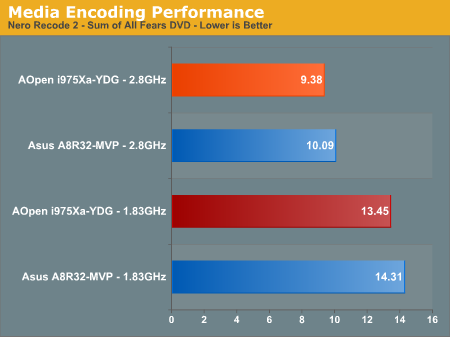
The results are very interesting as we did not expect the Intel system to perform this well. We were so surprised that we ran the test several times and verified our settings before accepting the test results. We guess the last few years of NetBurst results have tainted our cognitive abilities.
Our next test has us extracting Chapter 9 of our movie which will be used extensively in the rest of our benchmarks. After extraction we utilize AutoGK version 2.27 and DivX 6.2.1 to convert our .VOB file into a more accessible .AVI file. We utilize our standard settings and then let this program combination do its magic. We are reporting the numbers in two charts with frames per second and the time in minutes/seconds to complete the conversion.
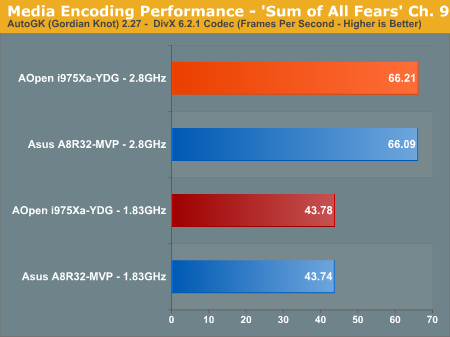
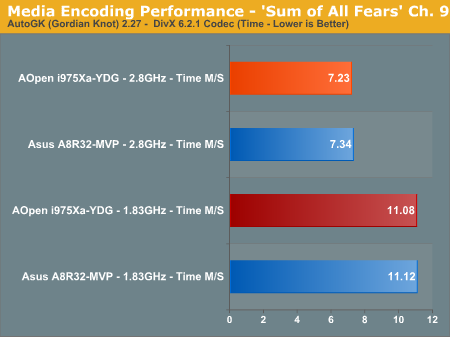
Unlike our Nero Recode 2 test results, this exercise has both systems performing equally. It either means this software is not optimized for a particular platform or the process is equally demanding on both systems.
Next on the list is the Windows Media Encoder 9 test that will convert our newly created .AVI file into a plasma screen pleasing WMV-HD format. We ensured our quality settings were set to High Definition. The values reported are in minutes/seconds for the conversion time, with lower numbers being better.
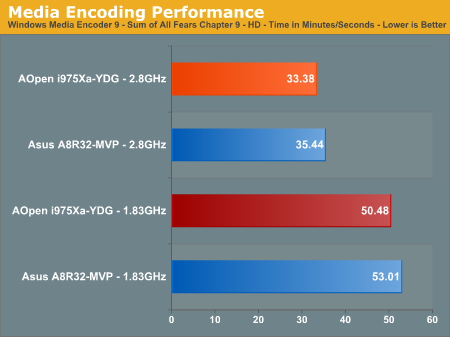
Once again, the Core Duo and the Opteron are close in the benchmark scores with the Intel platform performing up to 6% better in this benchmark. While both platforms are extremely competitive in this benchmark, the AOpen board clearly has the advantage in our scores.
Our final video tests utilize the Videora Converter products to perform a conversion of our Sum of All Fears Chapter 9 .VOB into the proper video format that our Xbox360, iPod, and Sony Playstation Portable can understand. We utilized the default settings for each program and have reported the results in minutes/seconds with the lower numbers being better. The final results show the transcoding process times for converting our standard 327MB file into a 43.2MB file for iPod, 111MB file for Xbox 360, and a 66MB file for PSP.
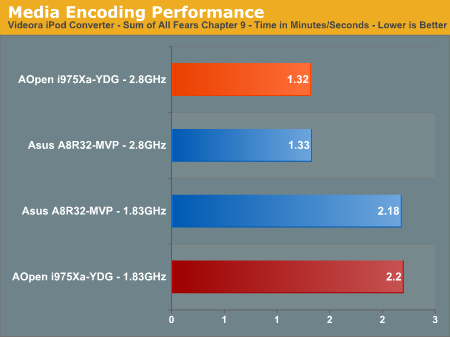
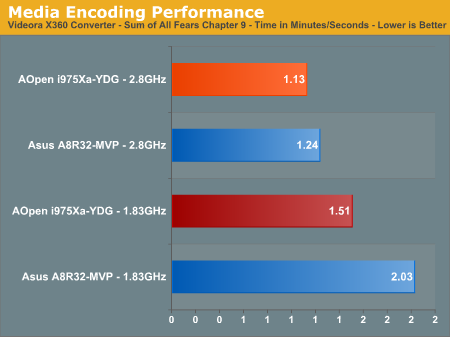
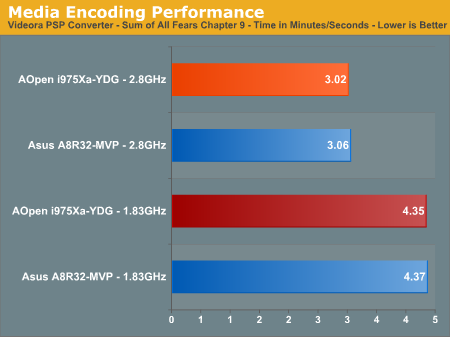
In these particular benchmarks both platforms are basically even with a minimal advantage going to the Intel platform in the more demanding Xbox 360 conversion. These results continue the pattern of the Intel Core Duo platform not being at a distinct disadvantage when compared to the current AMD offerings and actually having an advantage in most instances. Intel users can begin to rejoice now - just no dancing in the streets until the next product release please.










81 Comments
View All Comments
JarredWalton - Thursday, May 4, 2006 - link
Why did someone mod this post down? I'm serious: if you put an H in brackets, the AT comments engine interprets that as "turn on white text". No insult was intended towards HardOCP; I'm merely pointing out that Frumious' post turned the text white, unintentionally. Thanks for the negative mod points.... :|Frumious1 - Thursday, May 4, 2006 - link
Anyone else getting white text? What's up with that?Test:
[/font]
[/link]
Did that help?
goinginstyle - Thursday, May 4, 2006 - link
At least the quote was a bit different this time but still not needed. I thought the article was great and actually one of the best ones I have read lately. It was nice to finally see two like platforms compared against each other with the same cpu speeds and components although AMD2 would have been good to see.You really should do more of these comparisons as the reviewing one motherboard against another in the same product family gets boring. You never see much of a variance in the scores so the only question is if it sucks or not. At least this way you review the board and compare it against something you might be thinking about buying if you are a Intel or AMD user. You honestly get to see what works best for you. It was nice to see additional real application benchmarks instead of the same old winstone that or 3dmark this.
I was disappointed in not seeing any Photoshop benchmarks or something that has to do with graphics, it would round out your audio and video benchmarks nicely. Anyway, keep up the good work and hopefully you can do this same type of article when Conroe gets here against the AMD products.
In the meantime props to Intel for finally showing some performance improvement without needing a nuclear powerplant for the CPU.
goinginstyle - Thursday, May 4, 2006 - link
Any numbers yet?goinginstyle - Thursday, May 4, 2006 - link
....and temperature readings???Gary Key - Thursday, May 4, 2006 - link
We pulled the charts, the AOpen board uses a thermal sensor instead of the on-chip diode so our numbers are off. Once we decide what number to utilize, these numbers will be posted. If you refer to our Yonah Preview article, the power consumption numbers are listed for the 945GM board. I posted a couple of numbers earlier in this thread with the AOpen board. Thanks....goinginstyle - Thursday, May 4, 2006 - link
Thank you for the update and hopefully we can see these numbers soon.BigLan - Thursday, May 4, 2006 - link
"The rear panel contains the standard PS/2 mouse and keyboard ports, parallel port, LAN port, and 4 USB ports."Looking at the picture, I don't see a parallel port there and it's not listed on the specs either. Did you mean a firewire port?
Also, how useful is the external sata connector? Does the board come with a cable to utilise the power connector?
Gary Key - Thursday, May 4, 2006 - link
Sorry about that, yes, it was suppose to be Firewire. I had it corrected on my final draft and missed it twice in the edits.AOpen ships an excellent cable that has the drive and power port plugs together. I found the external connector to be very useful during testing on the JMicron chipset. Since I really enjoy HTPC tinkering, it will be of great usefulness for attaching or swapping large PVR drives out without entering the system. The JMicron chipset performed very well in our testing and had no issues handling Seagate's new 750GB drive.
BigLan - Thursday, May 4, 2006 - link
Thanks for the reply. Any chance you need an independent review doing on that 750GB drive ;)